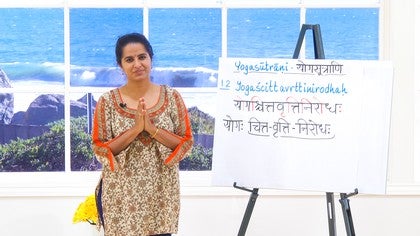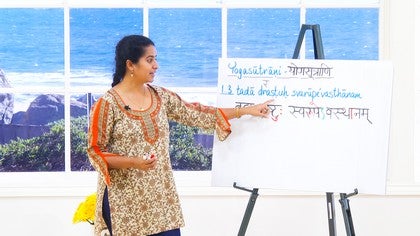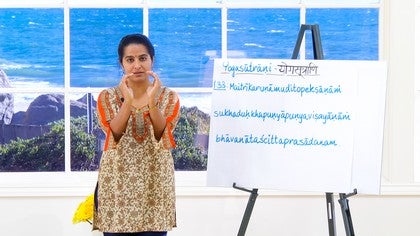Description
About This Video
Transcript
Read Full Transcript
Namaste dear friends, Swagatam and happy to have you back again. We have been looking at the different letters of the Sanskrit alphabet to see how they sound, what they look like and then how we write them out. And then we have played a little bit with trying to combine all of this together, especially with a little more emphasis on writing it out. Today we are going to explore this adventure of writing the Sanskrit letters but in a context that you are probably a little more familiar with. We will look at some of the sutras from Patanjali's Yoga Sutra.
What we will look at is the sutra number 1.2, which is the second sutra from the first chapter and is the definition of Patanjali of the yoga practice. And here it is, Yogashchitta Vritti Nirodha. The word Yogashchitta Vritti Nirodha is composed of different words. We have Yogaha Chitta Vritti Nirodha. Before we go into that, I think I will just like to show you how this particular word is written out or this particular sutra is written.
So we have seen the year and then you add the vowel o. I will put the vowels in a different color so you know how they are combining or what the symbol is. So it's yo, ga. Now the ga because it has the vowel er does not take any extra symbol with it. So ga.
You have to pay attention now, we have shchi. You remember with the e, the short vowel e, it has to come before there is a stick that precedes the combination of consonants it follows. So we have to put that stick in, we will not yet put the hook which indicates the e because we don't know where the letters will end. So the sh which is also written as sh, that's the half one and then there is a ch. So that's how they would combine where it takes the prop of the ch, the stick of the ch and then we add the hook on top of that chi.
So yo, ga, sh, chi and then we have a double t sound with the vowel er. So because of the vowel er there is no extra symbol you need to think of and therefore the doubling is th, the double t, ch, th and then you have the combination r which is the v and you add the r below it, that's what it becomes. Then we have the, again you have a double t and an i, it's the short i which implies that the stick will come before it with the hook. So we will put that there, we put the stick but because we don't know how far the t will extend, we will put that there first. Now we know where the hook has to join, vritti and then you have the ni, so again you have an i, you know what to do, you place the i stick before, then the na which is a dental na and you know that it's a dental sound because there are no dots on the letter n itself, there is no dot or indication.
So you have the ni, the hook, the stick and the i and then we have the combination of the consonant r with the vowel o. So the consonant r is written like that or that is the semi vowel r and then the o is a stick beside with the antenna on the head. And then we have the next combination which is the d, as you can see since there is no dot below it, it implies that it's the dental d. So that is represented like that, since it's the vowel r, there is no extra symbol of vowels that gets added to it and then you have the aspirate h at the end which is marked by the two dots, there you go. So we have yo, ga, sh, chi, the, v, ti, ni, ro, da, da, there we are.
Would you like to try saying that, yo, ga, sh, chi, the, v, that's the double t, t, i, n, i, ro, da. Now as I mentioned earlier, the term yo, ga, sh, chi, the, v, ti, ni, ro, da is composed of four words and the words are yo, ga, ha, I will write it out and now I will start writing only in the Devanagari script so that you start familiarizing with that particular way of writing these sounds. So yo, ga, this, this, sh is actually a combination of the pure aspirate ha, that is the visarga with chi. So if you say yo, ga, chitta, yo, ga, chitta, yo, ga, chitta, yo, ga, chitta, if you say it really fast, it will end up becoming yo, ga, chitta, yeah and that's what we are seeing happens here. So it's called a euphonic combination or the sandhi, in Sanskrit it would be called sandhi which is a joining and here it's the joining of the sounds.
So yo, ga, chi and you break it up, it would be yo, ga, ha, chitta, vritti and nirodha, ni, ro, dha, ha. I find it extremely helpful to say the sounds as I am writing that because as you say the sounds and write it and see it, you are creating multiple networks in your brain with the same piece of information and they say that the more networks, the more neural networks you connect with a single piece of information, the better it gets embedded in your mind, in your brain and easier to recall. So I would suggest become like children again and as you see them write, they just keep saying the sound again and again as they write it. Just do that a few times till you feel confident about knowing the sound for yourself. So here we go, yo, ga, chi, ta, vritti, nirodha.
This chitta, vritti, nirodha is actually not a separate word in this context because chitta means mind, vritti, the movement and nirodha, nirodha is the cessation of that. So that in this particular context is a compound word. It becomes cessation of the movements of the mind. So that's another fantastic characteristics of the Sanskrit language where you can just weave in these different words to give you one composite idea in just one package. You don't have to say it in a lengthy manner, you can just condense it.
That's also the unique feature of Sanskrit which is known for its brevity. Now we have the term, yo, ga, chi, ta, vritti, nirodha and we saw how the aspirate becomes the shch. Like we had mentioned in the previous lesson of the ashtanga yoga, we see that there is the sibilant shh and then there is the sound t that follows it and one might have this doubt about which s do we use. Is it the palatal shh, the cerebral shh or the dental shh and the tip that I had given you there was that pause with the shh, listen to the next sound. Determine the group of pronunciation of that next sound and then the shh will belong to that same family of sounds.
So in the case of ashtanga it was ashta, tanga, so t there belongs to the cerebral family therefore the shh would have to belong to the cerebral category. We see the same phenomenon happening here. We have shch, you see that it's more clear in English in this case. So you have shch, chi. How would you know which s to put in, pause, listen to the next sound, chh, chh belongs to the palatal group of pronunciations and therefore the shh will also belong to that group and therefore we have the shh with an accent which represents the palatal shh.
There you are in the devanagari script. So yoga, chitta, vritti, nirodha, if you say it really fast forward it would become yoga, shchitta, vritti, nirodha. A few letters that I would like to draw your attention to especially if you belong to the English speaking part of the world. We have some letters like the dental, you have all the t's and you have the d's. In English since the sound doesn't really appear, you have to pay attention that it is the dental or the soft sound.
So it's chitta, vritti, nirodha, an aspirate sound there. So try saying that once, yoga, shchitta, vritti, nirodha. Would you like to say that looking at the Sanskrit? Try yeah, yoga, shchitta, vritti, nirodha, uttamam, excellent. You're doing really well.
So stick with it and I have no doubts that you will get it without much of a trouble. Okay so I look forward to seeing you again. Shubham astu, may well-being be yours.







You need to be a subscriber to post a comment.
Please Log In or Create an Account to start your free trial.